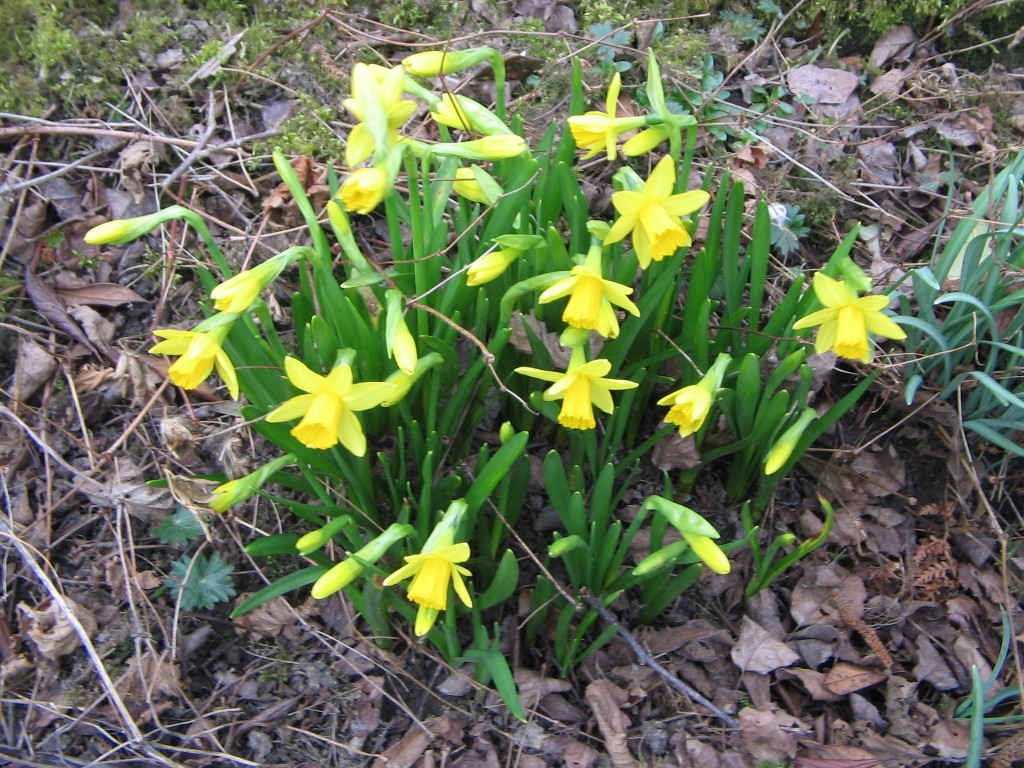
A greenhouse can be an ideal place to force daffodils into bloom in early spring. If the bulbs have been potted in fall and kept in a place that is cold but not freezing, they will have gotten the 12 to 14 weeks of chilling they need. Now they can be brought into the warmth and light of the greenhouse and hurried into golden bloom.
Daffodils in the ground have had a harder time this year. When the snow finally melted in my Chicago-area garden in late March, it revealed dozens of tiny greenish-yellow sprouts. They were the tips of daffodil leaves, poking up from the still-cold and, in many places, still-frozen soil. Though they were ready to grow, the snow (as well as a layer of leaves that never got raked last fall) kept them from getting the sunlight they needed to develop chlorophyll to turn their leaves a healthy green color. They were blanched, kind of like fancy asparagus.
Now that they are exposed to the sunlight of the growing days (because the snow melted and I have finally raked the leaves) they will green up. If there is a severe late freeze, it may damage the tips of the leaves but is not likely to touch the flower buds, which aren’t up yet.
I have a wide range of daffodils in my yard, from tiny early ‘Tete a Tete’, which sometimes flowers when there is snow on the ground, to some fairly baroque varieties with double and triple blooms. People have been hybridizing the members of the genus Narcissus for several centuries now and there are enough different kinds to suit any taste.
I tend to prefer single colors, with blooms that are all yellow or all white, though I have several shades of each. But some people love bicolored daffodils with highly contrasting petals and cups in shades of yellow, white, pink and punchy orange.
Though I have rousted some daffodils from my garden for being too gaudy—no orange for me—they rarely fail to thrive. Daffodils are tough. They are dormant and drought-tolerant in summer, and animals don’t like to eat the bulbs in winter.
When bulb catalogs talk about “naturalizing” narcissi, they mean that narcissus plants will last for decades with little or no care. They won’t typically reseed and scatter themselves, but over time, a daffodil plant in a good spot will multiply to form a clump.
Sometimes, a big dense clump will get so crowded it will stop flowering. In that case, you can dig it up in late spring after bloom time, divide the cluster of bulbs, and replant them over a wider area. The liberated bulbs will bloom next year with new vigor.
This is rarely necessary, though, and in general the biggest mistake people make with daffodils is to mess with them. They are better neglected. It’s important to leave the foliage after blooming and not cut it back to try to tidy it up; the plants need those leaves to gather enough sunlight to build next year’s flower-packed bulb. The best thing is to plant daffodils alongside other perennials that will overgrow the daffodil foliage or just distract the eye from the daffodil leaves.
When the leaves start to turn yellow, you know the plant is done with its foliage and is starting to go dormant for the summer. Then you can cut the leaves back.
Those daffodils that you forced into bloom in the greenhouse can go in the garden after they flower too. Plant the bulbs with their leaves in well-drained soil in full sun and water them well. Then leave them alone and they probably will flower for many springs to come.


